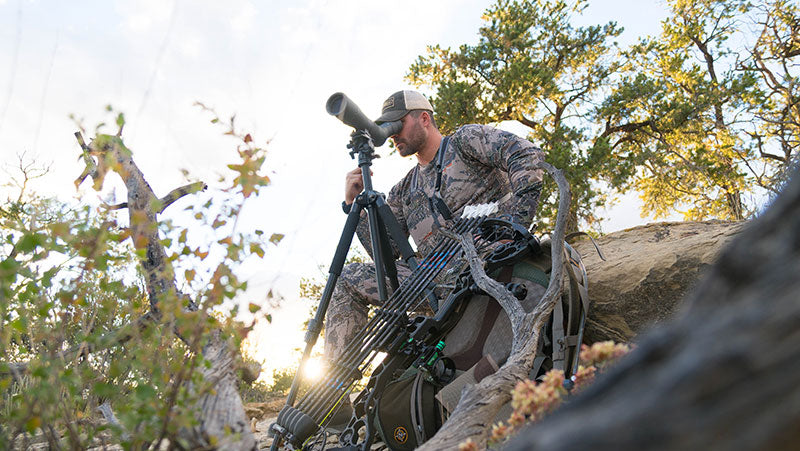Image Courtesy of Game of Inches TV
Author bio: I am James Nelson, an outdoor and hunting enthusiast. I have dedicated my time to gather and sieve through information about hunting. You can check out huntingresearch.org to learn more about me and my goals.
Spot-and-stalk is basically the art of hunting on foot. While many of us would think it is difficult to slip in on deer and elk without them noticing, the game of spot-and-stalk is actually not that complex. Successful stalkers would simply say that it requires you to be patient. Of course, your other basic skills on hunting must be good too. You can learn what these basic skills are at Hunting Research.
Chris Denham, part owner of Wilderness Athlete and editor of Western Hunter Magazine spends a great amount of time each year trying to be a ghost on the field. According to him, spot-and-stalk hunting is common sense. You just need to stay out of the animal’s sight, nose and ears, and do this with a healthy amount of patience. When hunters try to rush, that is when they get busted.
When properly done, foot hunting is very effective and also extra challenging. Instead of waiting in your tree stand or ground blind, you are actively pursuing game. Foot hunting with a bow is even more versatile and deadly. Whitetail deer are more vulnerable to stand hunting majority of the time. However, elk and mule deer are less predictable and are more likely to be shot by a sneaky bowhunter.
To stay hidden from deer as to not alert them during your hunt, there are a few tips that you can apply. Here are 8 tips for bow hunting on foot.
Tip One: Start at A High Point
You may not be able to do this everywhere, but if possible, set yourself up at a high ground to get a good vantage point. You can find elevated places such as trees, hilly terrain or rocks. If you see no elevated areas near you, move to check the next area. Bring your useful tools like a spotting scope or binoculars. Looking out from a higher ground can show you how the land lays. You will be able to see the game in your line of travel. You should take your time to look for game with your scopes as it will help you plan your hunting journey. It is okay to start off slow as this gives you time to plan your strategy as you scan the terrain and look at the bigger picture instead of moving in too quickly.

Image Courtesy of Game of Inches TV
Tip Two: Use the Weather to Your Advantage
It is easier to stalk deer when their senses are dulled. Since weather-related factors like wind, snow and rain can reduce the effectiveness of their sensitivity, use this to your hunting advantage. Be aware of the wind direction so you can avoid the animal catching your scent as you approach. To avoid getting detected, stay downwind of the animal, meaning that the wind should blow towards your face. It is helpful to use a wind checker to monitor the wind direction and ensure the wind is in your favor before you carry on. Wyndscent offers a great wind checker called the Wyndscent Grenade. It is really simple to use and puts out actual vapor. Wyndscent offers scented sticks like earth, pine, doe estrus, or elk estrus, and they also offer scent free sticks for just wind indication.

Image Courtesy of Become 1
Tip Three: Tune in To Your Senses
Use your senses to be aware of your surroundings. Sharpen your ears to listen to the sounds around you. They could reveal the location of the animal. Certain animal sounds can indicate that other animals or birds are aware of you, like the chattering of squirrels, crows cawing or deer snorting. You should also look closely around you to detect signs that can help you detect prey. Look for fresh tracks and signs of animals like droppings or bedding areas. When you walk, move slowly and take a few steps and a time so that you can scan and study your surroundings. Always prepare yourself and be ready because a shot could suddenly present itself! You should also stay open minded throughout your stalk and listen to your gut. Your instincts can take you a long way in a successful hunt.
Tip Four: Dress Strategically
Unless it is very cold, you may want to wear one layer less than you would to hunt from a tree stand or a ground blind. This is because you can get hot much faster when you stalk due to the increased movement. You do not want to sweat too much because it can make it easier for animals to detect your scent. You should also make sure your clothing is made of quiet material. It is worth spending a little more time and money to get one. You would not want your clothes to make unnecessary sounds as you walk through the woods that will scare game away.
Tip Five: Use Helpful Tools
A rangefinder is of great help in your spot-and-stalk hunt. Though you may know how to judge yardage, there is no substitute for the use of a rangefinder. It will not only make your life easier but make your hunt more lethal as well. During a stalk, you will constantly be ranging your quarry. Choosing a rangefinder harness that keeps it close by can let you crawl and quickly raise and lower your glass without making noise. You should also use items that can minimize noise to silence any piece of your gear that tings or clicks, like adhesive fleece or moleskin. Some bowhunters cover the inside of their riser shelf with fleece so that there is no way their arrow can be heard. Another helpful tool that you can use for the hunt is a decoy. A lightweight decoy comes in handy when stalking a deer. It is easy to carry but you may need a friend to tag along if you decide to use a big decoy.
Tip Six: Camouflage Yourself
The best thing you can do to camouflage yourself into nature is by wearing camouflage clothing. You should make sure your clothing matches the terrain you will be hunting in. You should also use all the cover available to you such as trees, brush and other foliage to conceal you as you approach the target. Using contour is just as important as using cover. This means that hills, ditches and other changes in topography can be a huge help to keep you hidden during the stalk. Stalking is all about angle management. You should study the contours of the land and plan an approach which keeps you camouflaged. You may even need to belly-crawl to achieve this. Use these terrain features to your advantage so that you can get closer to the animal you are after.

Image Courtesy of Game of Inches TV
Tip Seven: Move Quietly
There are different ways you can walk quietly in the hunting field. One way to make less noise is by slowly setting your foot down from heel to toe. You should also always feel the ground with your feet. If you feel a stick or a twig, slowly pick your foot back up and step over it. Some hunters use Cat Paws which are basically large felt pads attached to the bottom of the boots. This can make staying quiet when walking on rocky terrain much easier. Sometimes, spot-and-stalk hunting may require you to crawl. When your knees, hands and feet drag across the ground, this can make noise. Hence, you want to be as careful as possible. However, for bowhunting, it is better to walk than to crawl if possible because you need to get into the bow-shooting position.
Tip Eight: Remain Calm and Collected
In the last 100 yards, you will probably feel the most excited and yet nervous. At this time, you should not rush to finish the last part of the stalk. Instead, try to remain calm and take your time. In fact, this part may even take hours to complete depending on the situation. If you find your heart pace and your breathing picking up, take a few moments to compose yourself before resuming. Evaluate the situation and if the animal you are after is calm and staying put, you can relax for a minute and calm yourself down. Check the range and wait for the perfect opportunity to come to a full draw.

Image Courtesy of Game of Inches TV

